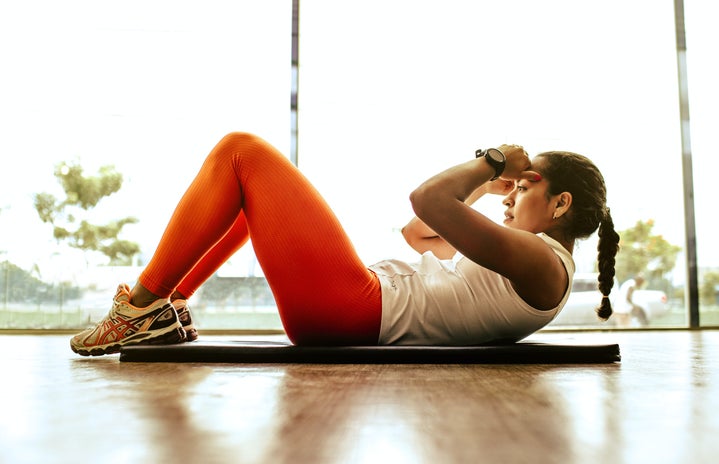There are many products out there for dealing with menstruation. We all know the classics, pads and tampons, but the use of menstrual cups is becoming more and more popular. For those of you interested in giving the menstrual cup a try, here are some key things all of us menstruators should know!
1. They are reusable — which is good for the environment and your wallet.
The eco-friendly aspect of the menstrual cup is what drew me to this product in the first place. Over the average menstruating person’s lifetime, tampons create 300 pounds of waste, and menstrual products (including panty liners) cost a total of $2,216.66. Menstrual cups are an investment, averaging around $50 per cup, but can last for up to 10 years. For an average 38 year menstruation cycle, that’s just $200. However, I am constantly losing the glasses off my face, and the thought of keeping something for ten years seems like a daunting task. Luckily, I’ve managed to hold onto mine for a year — and I’ve had it ready for every period. I did leave it in my boyfriend’s mother’s shower once, though, so that was a fun phone call to make.
2. They are better for your vagina than tampons.
Tampon retailers are not legally required to disclose the ingredients that they use. As a result, tampons are often home to some chemicals that you may not want to be in your vagina. Cups are often made of silicone, also found in lubes and sex toys, and there is virtually no risk of toxic shock syndrome (which we all have been conditioned to be terrified of) if you clean it regularly.
3. There are more brands than just the Diva Cup!
The Diva Cup is definitely a brand that many people associate with menstrual cups. However, the Diva Cup is just one cup, and they all differ! Vaginas come in all shapes and sizes, and the Diva Cup may not work for you. Cups come in different lengths, textures, colors, shapes, and sizes. A pro about the Diva Cup is that it is typically a great cup for beginners because of its durable and firm hold. In addition, it holds a larger amount of blood than some other cups. However, a common complaint is that it is generally too long for the average cervix. Your cervix moves up and down throughout the month and is typically at its lowest when you are menstruating. If you’re wondering where your cervix is, put your finger in your vagina and feel for the top and a firm surface. Use your thumb to note how far your finger is inside, and then measure that length. If the length is shorter than the Diva Cup’s length, then you might want to think about investing in another cup.
4. It likely WILL take practice.
It is a somewhat intimate process to get to know your menstrual cup and how it fits inside you. There will be fingers inside your vagina and there will be blood. Using a menstrual cup allows for learning to happen. How high is your cervix? Is your vaginal canal tilted? How much blood, to the milliliter, do you bleed on the first day of your flow? Using a cup, you will learn the answer to all of these questions, and you’ll also learn how to deal with stress and frustration.
The first time I used my cup, I managed to get it positioned properly so it wouldn’t leak. When I went to take it out, I didn’t know what to expect, and kind of just… tugged. It was suctioned to my cervix, and I didn’t realize I should pinch it first to un-suction it, so it took lots of tugging. When I finally got it out, it came out with so much force that I spilled all of the blood onto the floor of the bathroom and dropped the cup in the toilet. Mortified, I fished my cup out and cleaned up the crime scene.
More recently, I decided to try a new fold. After almost a year of loving my Diva Cup and never having any problems with it, I began leaking constantly and feeling discomfort with the placement of my cup. It took about two cycles to realize that the cup was not opening up inside of me and was laying in my canal folded up. Once I learned the trick for this particular fold, the cup was able to open up, and everything was sunshine and rainbows and unicorns again.
5. You can keep it in for up to 12 hours.
Tampons leak and can be dangerous if left in for more than five hours. Take that, double it, and add two. That’s how long your menstrual cup can stay inside you. If you have a heavy flow, you might need to change it more often, but it’s rare that you can produce more blood in just 12 hours than the Diva Cup can handle. You don’t have to worry about it while sleeping, on a plane, doing sports, at a concert, or at work or school. This is the #1 reason why I love my menstrual cup. With a flow as light as mine, putting in and taking out dry tampons is painful. A cup would never hurt you like that. The removal doesn’t cause pain regardless of how much blood you have produced.
6. You might poop it out on accident.
One of life’s cruel jokes is that menstruating can often be accompanied by diarrhea or frequent bowel movements. This can be extra frustrating if you choose to use a cup. While pooping out your menstrual cup is not very common, it is common for pooping to be uncomfortable or to dislodge the menstrual cup, as the movement involves bears down on the pubic muscles. It can be usually be pushed back into place using a clean hand, but can occasionally prove to be more difficult. For me, pooping with a cup tends to push the menstrual cup halfway out of my vaginal canal, which is why I choose to remove it. However, I also experienced similar discomfort and displacement with tampons, so it is in no way a deal breaker for me.
7. You can (unofficially) have penetrative sex while wearing it.
You’ll find a lot of evidence to the contrary, but it has been done. Anecdotally, people have reported having pleasurable penetrative sex while wearing a menstrual cup. Because of its placement in the vaginal canal and its malleable walls, a penis, sex toy, or other penetrative apparatus can enter the vaginal canal around the menstrual cup. It is NOT endorsed by any brand of menstrual cup, and many sexologists do not recommend it. There are single-use “soft cups” that are advertised as being safe for penetrative sex, if this seems too risky for you.
(This is your reminder that sex is good for you and your period symptoms, and not to feel ashamed of your period blood. Communicate, prepare, enjoy.)
8. It might change your life!
If you like what you’re hearing and are interested in learning more about menstrual cups before making the investment, here is great Youtube channel called Put A Cup In It, filled with visual materials, tips and tricks, reviews, new folds to try, and health information about menstrual cups. Happy bleeding!



